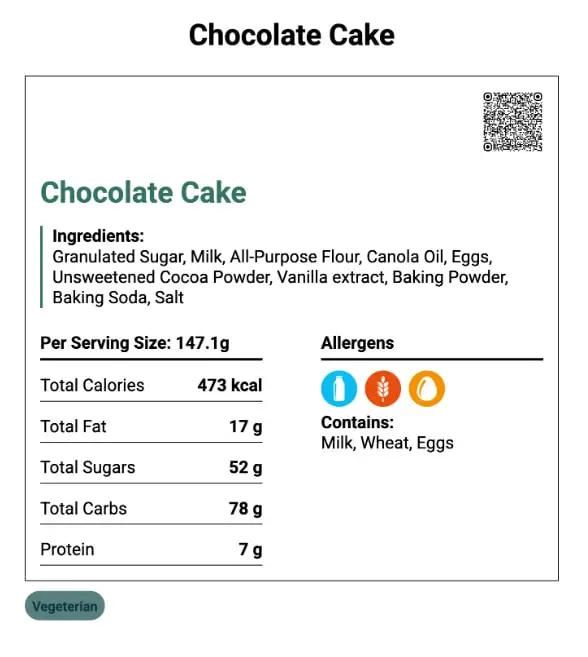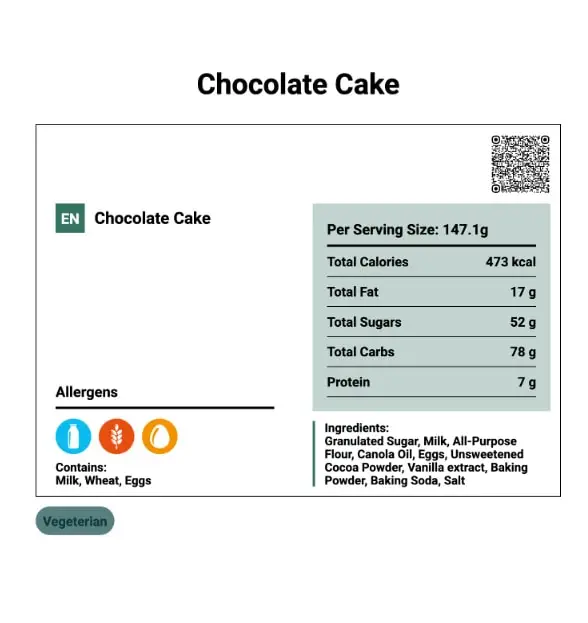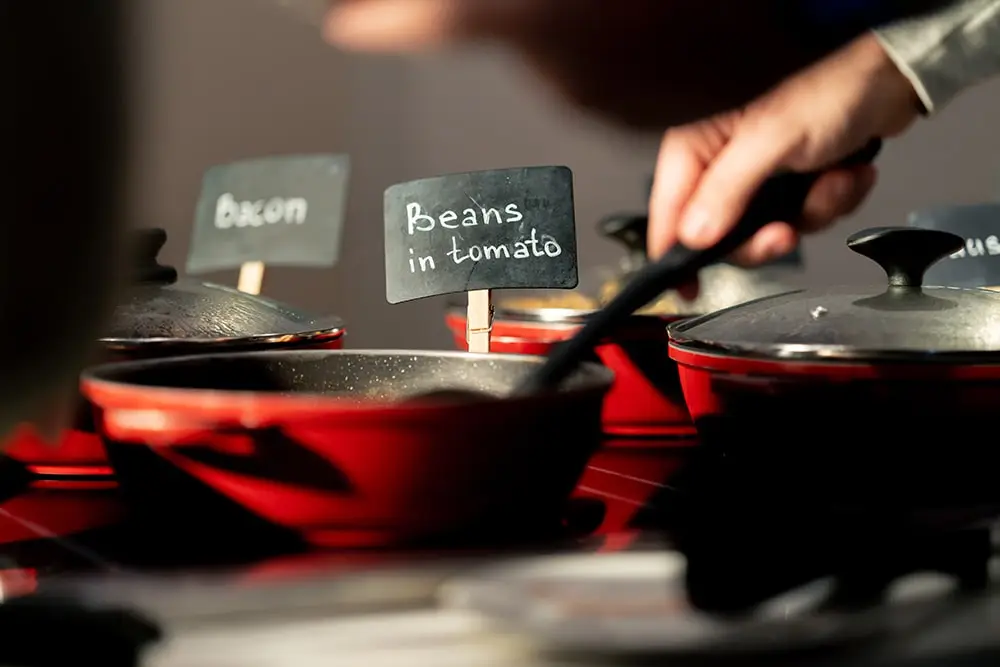Creating Clear Buffet Labels with Food Label Maker

Buffet labels play a critical role in food service, ensuring clarity for customers. Clear food labels help businesses provide essential information, including ingredient lists, allergen disclosures, and portion sizes. This reduces risks and enhances consumer trust.
This guide explores how to create accurate and clear buffet labels with ease, helping food service providers meet labeling requirements while improving customer experience. By prioritizing food safety and clear labeling, businesses can maintain transparency, protect diners with dietary restrictions, and build a strong reputation in the industry.
The Role of Buffet Labels in Food Service Compliance
Buffet food labels are essential for food service compliance and transparency with customers. These labels provide clear ingredient information, allergen disclosures, and portion details, helping businesses protect and educate consumers about what they are consuming. Proper buffet food labels further reduce the risk of allergic reactions, mislabeling, and food safety violations.
Failing to follow good labeling practices can lead to customer dissatisfaction and reputational harm. Accurate labels not only help businesses comply with accurate labeling standards but they can enhance consumer trust too.
See How FoodLabelMaker Can Help You
Essential Elements of an Effective Buffet Label
Food Label Maker’s Buffet Label Option 1:

Food Label Maker’s Buffet Label Option 2:

A well-designed buffet label provides diners with critical information at a glance, helping them make informed food choices that align with their dietary needs. Businesses should include ingredient lists and allergen disclosures to ensure transparency, basic compliance with food safety laws, and consumer safety.
Beyond compliance, clarity and accuracy are essential. Labels should be easy to read and placed near corresponding dishes, especially at self-service stations, catering events, and all-you-can-eat buffets, where customers rely on them for quick navigation.
The following sections will explore key requirements to help businesses implement safe and effective buffet labeling.
Ingredient List Recommendations

A clear, comprehensive ingredient list helps buffet guests make informed decisions about their food choices. When displaying ingredients at your buffet, they need to be listed in descending order based on their weight and in common names that are recognizable to each customer, giving them a good sense of what makes up each dish. Any additives or preservatives should also be clearly stated. This is particularly important for guests with dietary restrictions or allergies who need to know exactly what’s in their food.
For example, a chicken curry might list “Water, Chicken Breast, Tomatoes, Onions, Coconut Milk (Coconut Extract, Water, Guar Gum), Greek Yogurt (Cultured Grade A Milk, Cream)” so guests can quickly understand the main components. Many customers find that detailed ingredient lists not only help their guests feel more confident in their food choices but also reduce the time staff spend answering questions about dish components.
Buffet labeling standards might also differ based on food category and setting. Self-service buffets, catering services, and pre-packaged buffet items may require unique menu labeling formats to comply with regional regulations and enhance consumer safety.
Allergen Disclosure and Consumer Safety
Clear allergen information is crucial for buffet service, helping guests with food allergies make safe dining choices. When creating buffet labels, it’s helpful to highlight the most common allergens in each dish.
Many foodservice operators choose to emphasize allergens in bold text or with easily recognizable symbols. Many labels include text stating “Contains: Wheat, Milk, Tree Nuts” but Food Label Maker presents icons for common allergens like shellfish, eggs, or peanuts to create a more visually appealing and obvious way for customers to see allergens present.
Consider also noting potential cross-contact in your buffet setup. For instance, if items containing nuts are served near nut-free dishes, a simple note stating “Made in an area that also handles tree nuts” can help guests make informed decisions. Some establishments find it helpful to group allergen-free options together or use separate serving utensils for items containing common allergens.
Many customers have found that clear allergen labeling not only helps protect guests but, like in the case of ingredient lists, streamlines service by reducing the need for staff to answer repeated allergen inquiries. This proactive approach to allergen disclosure helps create a more welcoming dining environment for guests with dietary restrictions.
Formatting and Legibility Guidelines
Buffet labels must be clear, legible, and accessible to help customers make informed food choices. While specific legal formatting requirements may not apply to buffet settings in all locations, using best practices can improve readability and compliance with food safety guidelines.
To ensure clarity:
- Use large, easy-to-read fonts that can be seen from a reasonable distance.
- Ensure high contrast between text and background to improve visibility.
- Place labels directly next to the corresponding dish, angled for easy viewing.
- Avoid ambiguous terms and clearly mark allergens and dietary preferences.
For accessibility, businesses can bold allergens, use color-coded indicators, and provide printed or digital allergen lists to assist consumers with dietary restrictions. Well-designed buffet labels enhance consumer safety, prevent misinterpretation, and support compliance with food labeling best practices.
For an easier way to manage ingredients and keep labels accurate, try Food Label Maker’s Recipe Management Software.
Common Mistakes to Avoid in Buffet Labeling
Mistakes in buffet labeling can lead to legal risks if a consumer has a serious enough allergic reaction from your establishment, and pose an overall risk to consumer safety. Common errors include mislabeling allergens, inconsistent formatting, and failing to update labels when recipes change. Unclear ingredient information increases the risk of allergic reactions and compliance violations.
The following sections will explore these challenges in detail, helping businesses improve label accuracy, consistency, and compliance to protect consumers and avoid regulatory issues.
Mislabeling Ingredients and Allergens
Inaccurate buffet labeling poses serious health risks and legal consequences for businesses. Failing to properly disclose allergens such as nuts, dairy, gluten, or shellfish can result in severe allergic reactions, endangering consumers and leading to non-compliance penalties.
Mislabeling or omitting key ingredients can also erode consumer trust and increase liability risks for food service providers. Clear, up-to-date, and prominently displayed ingredient and allergen labels are essential for regulatory compliance and customer safety.
Businesses must regularly review and update buffet labels to reflect recipe changes, reformulations, or regulatory updates. There must also be clear information between chefs or individuals preparing the food and those labeling the various dishes. This is where the automation features and the consistent updates of food label software become vital and can mitigate many of the risks that manual labeling poses.
Inconsistent or Illegible Formatting
Poor buffet label formatting can lead to misinterpretation and compliance issues. Common mistakes include failing to list ingredients by their common or usual names, not declaring sub-ingredients, and listing ingredients out of their order of predominance. If a customer is standing in a busy queue and trying to dish up from a buffet in a hurry, they must be able to read large, legible text that is easy to interpret.
To maintain compliant food labels, businesses should regularly audit buffet labels to ensure consistent formatting, proper placement, and high visibility. Food Label Maker offers built-in quality control measures by creating consistently formatted labels. This allows food service providers to enhance readability, improve regulatory compliance, and prevent consumer safety risks.
Failure to Update Labels for Menu Changes
Outdated labels or menus may omit newly introduced allergens, misrepresent portion sizes, or fail to reflect ingredient substitutions. This puts customers at risk and exposes businesses to liability.
To maintain buffet label compliance, food service providers must routinely review and update labels to ensure they align with menu adjustments, reformulations, and regulatory changes. Regular label audits help prevent errors, protect consumers, and demonstrate a commitment to food safety and transparency.
How Clear Buffet Labels Improve Customer Experience and Safety

As demand for accurate food information grows, businesses can enhance customer experience and compliance with clear, consistent labels. Using nutrition analysis software ensures ingredient details and allergen disclosures remain precise.
Enhancing Transparency and Trust
When buffet labels consistently provide accurate and clear ingredient disclosures, customers are more likely to trust the establishment and return for future visits. Maintaining consistent and honest labeling ensures customers feel confident in their dining choices, especially when allergen and dietary information is clearly stated. Businesses prioritizing transparency meet consumer expectations and avoid misrepresentation issues that could lead to negative publicity or loss of trust.
By committing to clear and reliable food labeling, buffet-style establishments can differentiate themselves from competitors, reinforcing their reputation for honesty and customer care.
Supporting Dietary Preferences and Restrictions
Buffet labels play a crucial role in catering to diverse dietary needs, helping customers quickly identify options that align with their preferences. Clearly marked vegan, vegetarian, gluten-free, halal, and kosher labels ensure diners can make safe and informed choices without confusion.
Accurate dietary labeling prevents misrepresentation, protecting both customers and businesses from potential issues. Many diners actively seek restaurants that accommodate their dietary needs, making clear labeling a competitive advantage.
Businesses should calculate nutrition accurately to ensure that dietary markers are properly assigned, reducing labeling errors and maintaining customer trust.
How Food Label Maker Simplifies Buffet Label Compliance
Ensuring buffet labels are clear, accurate, and compliant with regulations is crucial for food service businesses. Food Label Maker offers a comprehensive solution to streamline this process, providing tools that assist with key aspects of buffet labeling.
Key features include:
- Ingredient Management: Efficiently organize and list all components of your dishes, ensuring transparency and accuracy in labeling.
- Allergen Identification: Automatically detect and highlight potential allergens in your recipes, helping to prevent allergic reactions among patrons.
- Regulatory Compliance: Stay up-to-date with food safety regulations by generating labels that meet current standards, reducing the risk of non-compliance.
- Customizable Templates: Choose from a variety of buffet label formats tailored to your specific needs and preferences. Food Label Maker provides foodservice labels that can be customized to include:
- Images of the dish for easy visual identification
- Ingredient statements with multiple language options for accessibility
- Allergen disclosures to ensure consumer safety
- Nutrition information for transparency
- QR codes for digital menu integration and additional details about the recipe
- Nutrition Analysis: Accurately calculate and display nutritional information, allowing customers to make informed dietary choices.
- Recipe Costing: Track and manage recipe costs to optimize pricing, maintain profitability, and ensure cost-effective menu planning.
By leveraging these features, Food Label Maker simplifies the creation of compliant buffet labels, enhancing both operational efficiency and customer trust.
Conclusion
Clear buffet labels are essential for regulatory compliance, food safety, and customer transparency. Proper labeling ensures accurate ingredient disclosures, allergen identification, and dietary markers, reducing risks and enhancing diner confidence.
Food Label Maker’s recipe management software simplifies buffet label clarity with automation, ingredient verification, and customizable templates, allowing businesses to create accurate labels with ease.
To improve compliance and streamline operations, prioritize accurate labeling, and enhance customer trust with Food Label Maker. Sign up today or view our pricing options to start your buffet labeling process and stay ahead of food safety regulations.
For more insights on food labeling best practices, visit the Food Label Maker blog and stay informed about industry trends and compliance updates.



